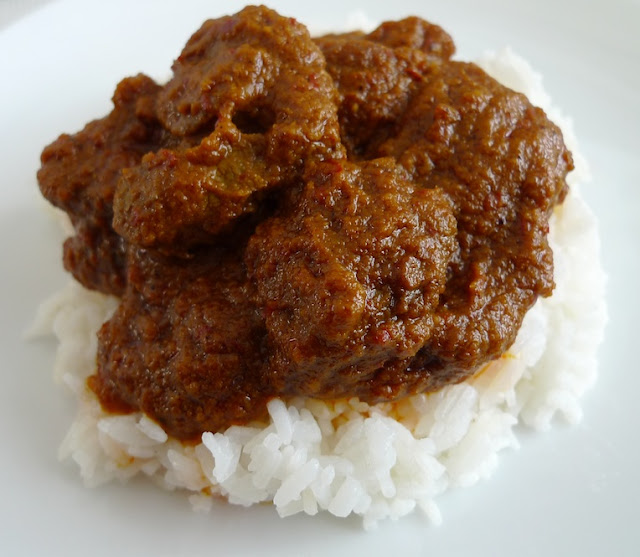I am not sure how it happened, but this fussy foodie has serendipitously flatted with not one but two friends who not only cook compulsively, but take a perverse delight in feeding the people around them into a stupor. And then there's M who is now a 'cook-off' junkie. Over the years, I have discovered that these peculiar creatures cannot be blamed for this apparently hereditary affliction. E caught it from her grandmother and S's parents have passed it on to all their children!
This is S's mum's recipe for the classic Malaysian/Indonesian dish - rendang. I have never tried cooking it myself - I leave all that hard work to S. Even with a recipe, it is not an easy dish to perfect, but when done right is absolutely 'roll-your-eyes-to-the-back-of-your-head' divine. Beautifully tender pieces of beef/lamb/chicken sitting in lovely, thick, rich, spicy, aromatic, sweetish, gravy/paste. There are several different versions with distinctly different flavour profiles (some are sweeter, some are more curry like), but the basic characteristics of a good rendang are as described. That rendang pictured above that S made with this recipe was stunning and close to perfection. Maybe one day when S isn't just a stone's throw away to cook for me, I'll have to attempt it, but for now I am quite content just depending on her charity. Perhaps you should try it and report your efforts - it actually requires a bit of practice to get right.
125g ginger
300g onions (large or shallots or a mixture)
150g garlic
100g "buah keras”(candlenuts), soaked for about 20 minutes
100g “serai“(lemon grass, root only)
50 g fresh “kunyit” (turmeric); or 2-3 tsp turmeric powder
6-8 tbsp chilli paste - instructions below
250g “kerisek” (fried desiccated coconut) - instructions below
3 tsp tamarind puree
55g palm sugar or white sugar
2 whole and 2 shredded kaffir lime leaves
1 piece “kunyit” (turmeric) leaf, shredded (substitute with fresh bay leaf)
Gravy beef/chicken/lamb chops (see estimate in the recipe below, you don't have to use all the paste)
Method
Chilli paste:
Top and deseed 1 bag (around 700gm) of big dried red chilli.
Boil in a pot of water for 5 minutes.
Drain and blend into a smooth paste (some water can be added if it gets too thick).
Fry in hot oil (on med to med-high heat) for 20-30 minutes.
When the oil separates and form a border around the side of the pan the paste is done.
Store in refrigerator, in an airtight jar, with a layer of oil on top.
Kerisek:
Dry fry 250g of desiccated coconut (use fresh if possible) on med-low heat.
This will take around 25 minutes.
Fry the coconut till it turns a lovely dark caramel colour.
Be sure to constantly stir the coconut so that it does not burn.
Let it cool, then using a spice blender or pestle and mortar, blend the coconut to a smooth paste.
You will notice that the natural oil will make the paste thick.
DO NOT add any liquid.
Rendang:
Grind to a smooth paste ingredients 1 to 6.
Fry this paste and chilli paste until oil comes up/separates (use a deep pan as it splashes) for about half hour or so, on med heat.
I ended using about ¾ to 1 cup of vegetable oil.
Add ½ a cup first, and add more (if needed) mid way through.
You basically want enough oil to fry this paste.
Add tamarind juice/puree, salt, and palm sugar (taste to ensure balance is perfect). Not too sweet please! Add leaves and kerisek, and cook for further 10 mins.
At this point you have a cooked paste that can be kept in the freezer for use in the future.
This recipe makes the amount of paste for about 5 - 6kg of meat (possibly more).
To make the rendang, add meat to a pan (with very little oil) and fry for 5 minutes.
Add enough of the rendang paste to coat the meat.
Add some water (a few tablespoons) just to loosen the paste.
Cover and slow cook until meat is tender. If using beef, this can take up to 2 hours. However, if you are using a pressure cooker, that should take less time.
When the meat is tender, add some coconut cream, sugar and salt (to taste).
If the sauce is too runny, slow cook on low heat, uncovered, for 20-30 more minutes.
Serve with rice, bread, naan or roti.

No comments:
Post a Comment